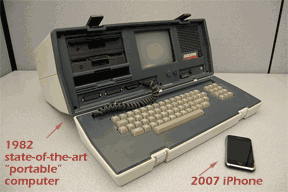Growth of technology
Exponential growth can be applied to "populations" that aren't even alive. For example, several years ago someone figured out that the growth of computing technology seems to be roughly exponential.
... For example, the power of the average CPU chip doubles about every 2 years.
... Back in the day (circa 1990) a 512K hard drive was considered pretty cool -- nowadays hard drives are measured in gigs and soon we'll be talking about terabytes
... phones, cameras, mp3 players -- all have grown exponentially.
Here's one example:
If you went out to buy one of the first digital cameras, in 1994, every 140 pixels cost about a dollar. In 2005, the same dollar (adjusted for inflation) bought you 20,000 pixels. So, the pixels per dollar doubled every years.
So how well does the exponential nature of technological change hold up? Surprisingly well... remember that a log-transformed scale should turn an exponential growth curve into a straight line. So, what do you expect to see on the graph below? Mouse over the graph to see if you are correct.
photo credits: computer and cellphone | graph
Copyright University of Maryland, 2007
You may link to this site for educational purposes.
Please do not copy without permission
requests/questions/feedback email: mathbench@umd.edu